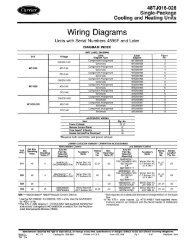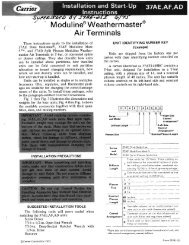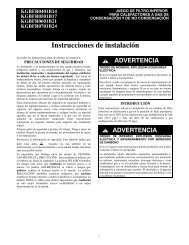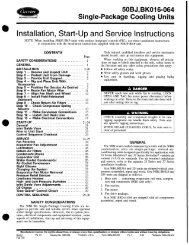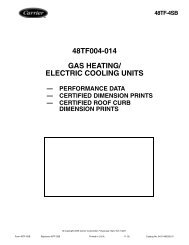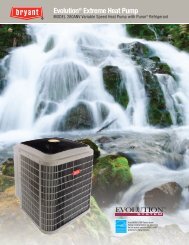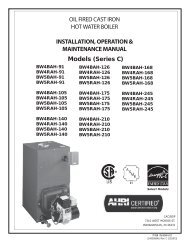Start-Up, Operation, and Maintenance Instructions
Start-Up, Operation, and Maintenance Instructions
Start-Up, Operation, and Maintenance Instructions
You also want an ePaper? Increase the reach of your titles
YUMPU automatically turns print PDFs into web optimized ePapers that Google loves.
TROUBLESHOOTING GUIDE<br />
Overview — The PIC II has many features to help the operator<br />
<strong>and</strong> technician troubleshoot a 19XR chiller.<br />
The CVC/ICVC shows the chiller’s actual operating conditions<br />
<strong>and</strong> can be viewed while the unit is running.<br />
The CVC/ICVC default screen freezes when an alarm<br />
occurs. The freeze enables the operator to view the<br />
chiller conditions at the time of alarm. The STATUS<br />
screens continue to show current information. Once all<br />
alarms have been cleared (by correcting the problems<br />
<strong>and</strong> pressing the RESET softkey), the CVC/ICVC<br />
default screen returns to normal operation.<br />
The CONTROL ALGORITHM STATUS screens (which<br />
include the CAPACITY, OVERRIDE, LL_MAINT,<br />
ISM_HIST, LOADSHED, WSMDEFME, <strong>and</strong><br />
OCCDEFCM screens) display information that helps to<br />
diagnose problems with chilled water temperature<br />
control, chilled water temperature control overrides, hot<br />
gas bypass, surge algorithm status, <strong>and</strong> time schedule<br />
operation.<br />
The control test feature facilitates the proper operation<br />
<strong>and</strong> test of temperature sensors, pressure transducers, the<br />
guide vane actuator, oil pump, water pumps, tower control,<br />
<strong>and</strong> other on/off outputs while the compressor is<br />
stopped. It also has the ability to lock off the compressor<br />
<strong>and</strong> turn on water pumps for pumpout operation. The<br />
CVC/ICVC shows the temperatures <strong>and</strong> pressures<br />
required during these operations.<br />
From other SERVICE tables, the operator/technician can<br />
access configured items, such as chilled water resets,<br />
override set points, etc.<br />
If an operating fault is detected, an alarm message is generated<br />
<strong>and</strong> displayed on the CVC/ICVC default screen.<br />
A more detailed message — along with a diagnostic<br />
message — is also stored into the ALARM HISTORY<br />
table.<br />
Checking Display Messages — The first area to<br />
check when troubleshooting the 19XR is the CVC/ICVC display.<br />
If the alarm light is flashing, check the primary <strong>and</strong> secondary<br />
message lines on the CVC/ICVC default screen<br />
(Fig. 14). These messages will indicate where the fault is occurring.<br />
These messages contain the alarm message with a<br />
specified code. This code or state appears with each alarm <strong>and</strong><br />
alert message. The ALARM HISTORY table on the CVC/<br />
ICVC SERVICE menu also contains an alarm message to further<br />
exp<strong>and</strong> on the alarm. For a complete list of possible alarm<br />
messages, see Table 11. If the alarm light starts to flash while<br />
accessing a menu screen, press the EXIT softkey to return to<br />
the default screen to read the alarm message. The STATUS<br />
screen can also be accessed to determine where an alarm exists.<br />
Checking Temperature Sensors — All temperature<br />
sensors are thermistor-type sensors. This means that the resistance<br />
of the sensor varies with temperature. All sensors have<br />
the same resistance characteristics. If the controls are on, determine<br />
sensor temperature by measuring voltage drop; if the controls<br />
are powered off, determine sensor temperature by measuring<br />
resistance. Compare the readings to the values listed in<br />
Table 12A or 12B.<br />
RESISTANCE CHECK — Turn off the control power <strong>and</strong>,<br />
from the module, disconnect the terminal plug of the sensor in<br />
question. With a digital ohmmeter, measure sensor resistance<br />
between receptacles as designated by the wiring diagram. The<br />
resistance <strong>and</strong> corresponding temperature are listed in<br />
Table 12A or 12B. Check the resistance of both wires to<br />
ground. This resistance should be infinite.<br />
76<br />
VOLTAGE DROP — The voltage drop across any energized<br />
sensor can be measured with a digital voltmeter while the control<br />
is energized. Table 12A or 12B lists the relationship between<br />
temperature <strong>and</strong> sensor voltage drop (volts dc measured<br />
across the energized sensor). Exercise care when measuring<br />
voltage to prevent damage to the sensor leads, connector plugs,<br />
<strong>and</strong> modules. Sensors should also be checked at the sensor<br />
plugs. Check the sensor wire at the sensor for 5 vdc if the control<br />
is powered on.<br />
Relieve all refrigerant pressure or drain the water before<br />
replacing the temperature sensors.<br />
CHECK SENSOR ACCURACY — Place the sensor in a<br />
medium of known temperature <strong>and</strong> compare that temperature<br />
to the measured reading. The thermometer used to determine<br />
the temperature of the medium should be of laboratory quality<br />
with 0.5° F (.25° C) graduations. The sensor in question should<br />
be accurate to within 2° F (1.2° C).<br />
See Fig. 9 for sensor locations. The sensors are immersed<br />
directly in the refrigerant or water circuits. The wiring at each<br />
sensor is easily disconnected by unlatching the connector.<br />
These connectors allow only one-way connection to the sensor.<br />
When installing a new sensor, apply a pipe sealant or thread<br />
sealant to the sensor threads.<br />
DUAL TEMPERATURE SENSORS — For servicing convenience,<br />
there are 2 sensors each on the bearing <strong>and</strong> motor<br />
temperature sensors. If one of the sensors is damaged, the other<br />
can be used by simply moving a wire. The number 2 terminal<br />
in the sensor terminal box is the common line. To use the second<br />
sensor, move the wire from the number 1 position to the<br />
number 3 position.<br />
Checking Pressure Transducers<br />
UNITS EQUIPPED WITH CVC — There are 8 pressure<br />
transducers on 19XR chillers. They determine cooler, condenser,<br />
oil pressure, <strong>and</strong> cooler <strong>and</strong> condenser flow. The cooler <strong>and</strong><br />
condenser transducers are also used by the PIC II to determine<br />
the refrigerant temperatures. The oil supply pressure transducer<br />
value <strong>and</strong> the oil transmission sump pressure transducer value<br />
difference is calculated by the CCM. The CVC module then<br />
displays the differential pressure. In effect, the CVC reads only<br />
one input for oil pressure for a total of 5 pressure inputs: cooler<br />
pressure, condenser pressure, oil differential pressure, cooler<br />
waterside differential pressure, <strong>and</strong> condenser waterside differential<br />
pressure. See the Check Pressure Transducers section<br />
(page 75) under Scheduled <strong>Maintenance</strong>.<br />
UNITS EQUIPPED WITH ICVC — There are 6 factoryinstalled<br />
pressure transducers, with inputs available for both<br />
cooler <strong>and</strong> The ICVC software will display a default reading of<br />
26 psi during start-up <strong>and</strong> operation. An additional transducer,<br />
factory installed in the bottom of the cooler barrel, will read as<br />
EVAPORATOR SACTURATION TEMP on the HEAT_EX<br />
DISPLAY screen. This provides additional protection against a<br />
loss of water flow condition.<br />
These pressure transducers can be calibrated if necessary. It<br />
is not usually necessary to calibrate at initial start-up.<br />
However, at high altitude locations, it is necessary to calibrate<br />
the transducers to ensure the proper refrigerant temperature/<br />
pressure relationship. Each transducer is supplied with 5 vdc<br />
power from the CCM. If the power supply fails, a transducer<br />
voltage reference alarm occurs. If the transducer reading is<br />
suspected of being faulty, check the supply voltage. It should<br />
be 5 vdc ±.5 v displayed in CONTROL TEST under CCM<br />
Pressure Transducers. If the supply voltage is correct, the transducer<br />
should be recalibrated or replaced.







